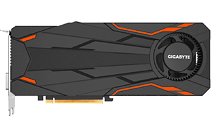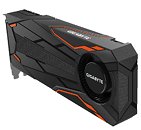Monday, October 3rd 2016

GIGABYTE Intros the GeForce GTX 1080 TT Graphics Card
GIGABYTE unveiled its very own lateral-blower cooled GeForce GTX 1080 graphics card, the GTX 1080 TT (model: GV-N1080TTOC-8GD). This card is characterized by the new WindForce Turbo Fan lateral-blower type cooler that pushes hot air out of your case, much like the reference-design (Founders Edition) card. It features a slick cooler shroud that has design elements from the company's Xtreme Gaming cards.
Under the hood, the cooler features a dense copper heat pipe-fed aluminium channel heatsink, ventilated by the lateral blower. This heatsink features three 6 mm-thick copper heat pipes that make direct contact with the GPU die, while an aluminium plate draws heat from the memory and VRM. The card offers factory-overclocked speeds of 1657 MHz core, 1797 MHz GPU Boost (OC mode); 1632 MHz core, 1772 MHz GPU Boost (out of the box); with the memory untouched at 10 GHz (GDDR5X-effective). The card draws power from a single 8-pin PCIe power connector. GIGABYTE didn't reveal pricing, although we expect this to be the company's cheapest GTX 1080 offering.
Under the hood, the cooler features a dense copper heat pipe-fed aluminium channel heatsink, ventilated by the lateral blower. This heatsink features three 6 mm-thick copper heat pipes that make direct contact with the GPU die, while an aluminium plate draws heat from the memory and VRM. The card offers factory-overclocked speeds of 1657 MHz core, 1797 MHz GPU Boost (OC mode); 1632 MHz core, 1772 MHz GPU Boost (out of the box); with the memory untouched at 10 GHz (GDDR5X-effective). The card draws power from a single 8-pin PCIe power connector. GIGABYTE didn't reveal pricing, although we expect this to be the company's cheapest GTX 1080 offering.




23 Comments on GIGABYTE Intros the GeForce GTX 1080 TT Graphics Card
When i get a spare $300 ill get a second GTX 970 to match my current one and I know it will run cool and quiet in SLi because of the blower design.
Die shrinks and a lot less power draw from todays cards helps alot with these blower design coolers :)
That single 8-pin power connector suggests some cost-cutting on the mobo design however with less overclocking potential, so it should be fairly cheap. It would be interesting to see how this compares to other GTX 1080s, especially the FE version.
@W1zzard Any chance of badgering you into reviewing it? ;)
EDIT: Yes, I have seen them with one connector, lol. My Palit one has two connectors because it's high end so I forgot, lol.
Copper heatpipes won't change that. And the FE managed to throttle and be an airplane.
The advantage of blower fans has always been that they remove the heat from the system, not just cirle it around.
There is a good chance that this board is using the reference design - thus a likely candiate for anyone wanting to put a custom loop on there or using a cheaper AIO solution.
Also, if Gigabyte have saved pennies with only one connector, it suggests that they've done that on the power circuitry too (and other places) which would very likely reduce overclock performance and have higher coil whine.
Also, a proper cooler is definitely better in almost all circumstances, but the blower coolers has their place in small formfactor enclosures as well as multigpu builds with close pci-e placementAre you for real or trolling, i cant tell. Most of the early cards were with one connector(since they used the ref design layout), the FE, the evga SC, MSI Aero, MSI Armor, even the MSI Seahawk, Asus Turbo are just some of the examples
www.techpowerup.com/gpudb/2839/geforce-gtx-1080
The original spec is 1x8pin and these cards are held back by cooling, not power delivery, and 180w TDP doesn't really require anything more, on 1x8pin there is even some headroom. It's just our overclocker's heart talking here.
@DarkHill power delivery is closely related to cooling solution. Lower temps = less current leakage = greater OC potential within the same power envelope. Regardless, the reviewed versions mostly hit 2000 mhz and are definitely using more than the original board TDP of 180w, and definitely have a use of extra power connectors and dó use more power in general. Up to the point that those cards lose the perf/watt efficiency Pascal is known for.
I checked the FE review afterwards and realized that my memory had gone into a silly meltdown over the number of connectors since my Palit one has two and then edited post 6 to reflect this. So yes of course, it's not the single connector that's holding it back, but the cooler, as you say. :)
Edit: just seen the correction at post 6 lol
Cooling ofcourse can have a major effect on the boost clock, so a properly cooled 1 pin /6 phase card will have a better and more stable OC than a 2pin 14+3 phased one have.
the 1080 really doesnt need more power. Pascal is running against a clockspeed wall, and all third party designs give you is a quieter design if you only use 1 GPU in a non cramped case.
1x6 + 1x8 pin MSI Gaming X + 2x8 pin Zotac
www.techpowerup.com/reviews/MSI/GTX_1080_Gaming_X/28.html
www.techpowerup.com/reviews/Zotac/GeForce_GTX_1080_Amp/3.html
Look at the clock median here.
Now look at this.
www.techpowerup.com/reviews/MSI/GTX_1080_Gaming_X/22.html
254w max
Now the Gigabyte G1 - 1x 8pin
www.techpowerup.com/reviews/Gigabyte/GTX_1080_G1_Gaming/22.html
www.techpowerup.com/reviews/Gigabyte/GTX_1080_G1_Gaming/28.html
Look at clock median and spread.
Note that these are all cards that don't throttle. Pascal wants more juice to keep a higher clock median and reduce clock spread, and runs past 1x8 pin+ PCIe slot power draw limits to do so.
With Pascal OCing, what matters is not the highest achievable clock on the card, but the highest average clockspeed across a full play session. And to get reliable results on that, you want more than 180w and additional connectors. This will ensure you keep your OC intact when the game load is 100% and pushing all buttons on the card. It may seem like a little detail at a glance, but its not - you especially WANT that OC performance when the game you're running really needs the performance, and only the cards with more connectors offer that - in other words, only those cards offer a meaningful OC, the others dip in clocks when the going gets tough.
Always keep in mind that every architecture has its own quirks, Pascal is a different beast than Kepler or Maxwell.